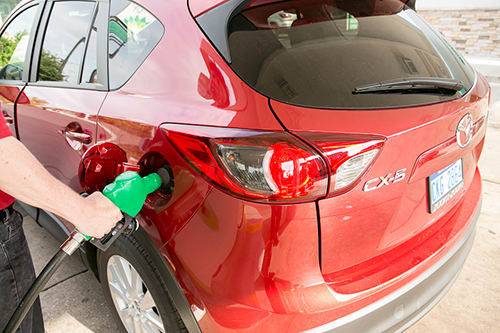Mazda Leads, Fiat Chrysler Trails in Latest EPA Fuel Economy Report


Mazda’s 28.1 mpg led all major automakers in average fuel economy for the 2013 model year, according to a new EPA report on industrywide fuel economy. Fiat Chrysler Automobiles’ 20.9 mpg, meanwhile, trailed the 11 automakers surveyed. The 148-page report notes that all major automakers except sixth-place Toyota and ninth-place Ford saw their averages increase between 2012 and 2013, and the industry’s overall 24.1 mpg is the highest average since the EPA began tracking the data in 1975.
Related: Gas Prices Are Up, But So Is Average MPG
Preliminary 2014 model-year data shows Mazda still in the lead, with 28.8 mpg. That beats Honda (27.6 mpg), Subaru (27.5 mpg), Nissan (26.8 mpg), Volkswagen (26.7 mpg), Toyota (25.8 mpg), BMW (26.0 mpg), Daimler (22.8 mpg), Ford (23.4 mpg), GM (22.0 mpg) and FCA (21.1). The overall 24.1 mpg incorporates corrected mileage from Hyundai-Kia, but the EPA didn’t include the Korean automaker in its rankings because Hyundai-Kia is under a continuing investigation for the mileage corrections it issued in late 2012.
Each automaker generally includes its major respective brands. That means Toyota includes Scion and Lexus, Daimler includes Mercedes-Benz and Smart, and so on. Of the so-called “full-line” automakers that build everything from subcompacts to pickups, Nissan leads Toyota and the Detroit Three. But the EPA doesn’t measure fuel economy for any vehicles with a gross vehicle weight rating more than 8,500 pounds. That means a handful of heavy-duty pickup trucks, vans and SUVs from the Detroit Three are exempt from the calculations.
There were some other interesting findings in the EPA report, particularly for data junkies:
- Engines are getting smaller. Overall displacement (2 liters, 3 liters, etc.) grew slowly from 1988 to 2004, the EPA notes, but it’s been on the decline ever since. In 2013, engines displaced just above what they did in 1987.
- That doesn’t mean they’re getting less powerful. Quite the contrary: Average output grew to 227 horsepower in 2013, up 5 hp from 2012. That’s about 100 hp more than in the late 1980s and about 50 hp above the late 1990s.
- Why? Credit technology. Variable valve timing is standard on virtually every 2014 vehicle, compared to about 70 percent of cars in 2009. Direct injection is in nearly 40 percent of 2014 models, up from just 4 percent in 2009. And turbochargers are also taking hold. Nearly 80 percent of today’s turbos go in four-cylinder cars — think VW’s GTI or Ford’s EcoBoost Escape — while just 21.2 percent are in six- or eight-cylinder engines. BMW is the biggest proponent, with 95 percent of its lineup sporting turbos.
- Idle-stop technology in non-hybrids accounts for only about 5 percent of the market, but that’s up from virtually zero in 2009. Again, BMW has the highest portion (75 percent).
- Six-speed transmissions account for nearly 70 percent of the market, up from about 25 percent in 2009. But continuously variable transmissions and transmissions with seven or more speeds account for another 30 percent of the market. That’s up from about 12 percent in 2009.
How’d the EPA come up with its overall mileage per automaker? It took harmonic (not arithmetic) averages based on a 43/57 percent city/highway driving mix across production mixes from each automaker. Don’t confuse that with the five-cycle, 55/45 percent mix used for fuel-economy labels — or the two-cycle, unadjusted figures used for corporate average fuel economy numbers, which tend to be a lot higher.
What about plug-in cars? The EPA rankings and industry average excludes electric vehicles, plug-in hybrids and compressed-natural-gas cars on grounds that owners will fill them mostly with electricity or whatever other alternative fuel they use, as they’ve paid “a substantial premium” for their car, and using it provides a means of recouping that cost. That makes it relatively difficult to assess a mileage impact, the EPA says.
That means these figures exclude cars like the Chevrolet Volt, Nissan Leaf and Toyota Prius Plug-In. The EPA notes that the total production of alt-fuel cars, including EVs and PHEVs, amounts to less than 1 percent of all 2013 production; if that changes, it will “determine on a case-by-case basis” when and how to incorporate them.
Cars.com photo by Evan Sears

Former Assistant Managing Editor-News Kelsey Mays likes quality, reliability, safety and practicality. But he also likes a fair price.
Featured stories




2026 Nissan Sentra Review: Long Live the Sedan

